It has been a busy fortnight, with house-moving (in progress) and secret projects (almost ready to start) and programming (proceeding nicely) and various other endeavours (far from complete), but I’ve finished all ambient crowd behaviour, and a couple of other things besides. Here’s a pretty massive round-up of what has been happening in the last three weeks since the last full URRpdate:
Priest Clothing
I decided to work last week on a second of the four high-level clothing archetypes (feudal, nomadic, hunter-gatherer, religious) – the religious clothing. For this I did a standard expansive image search, collated a range of religious dresses, and then attempted to break them down into commonalities, differences, and readily exchangeable parts. The colouring of each piece of religious clothing, much like the prayer mats we saw a few weeks ago, are connected to the altars they worship at. The highest-ranking priests in the religion will have slightly snazzier robes, whilst if the religion has any kind of poverty-is-holy ideology or similar, they might have duller robes. Here is a set of six possible robes all using a potential “demonic” colour scheme (just since that’s the one I was testing the systems with, but how nice do they look?!), and then some with their attendant altars alongside (one “Eldritch” archetype, one “Pantheon”, and two “Standard”), and lastly an example of the higher tier of religious clothing reserved for religious leaders (hence the lovely gold filigree):
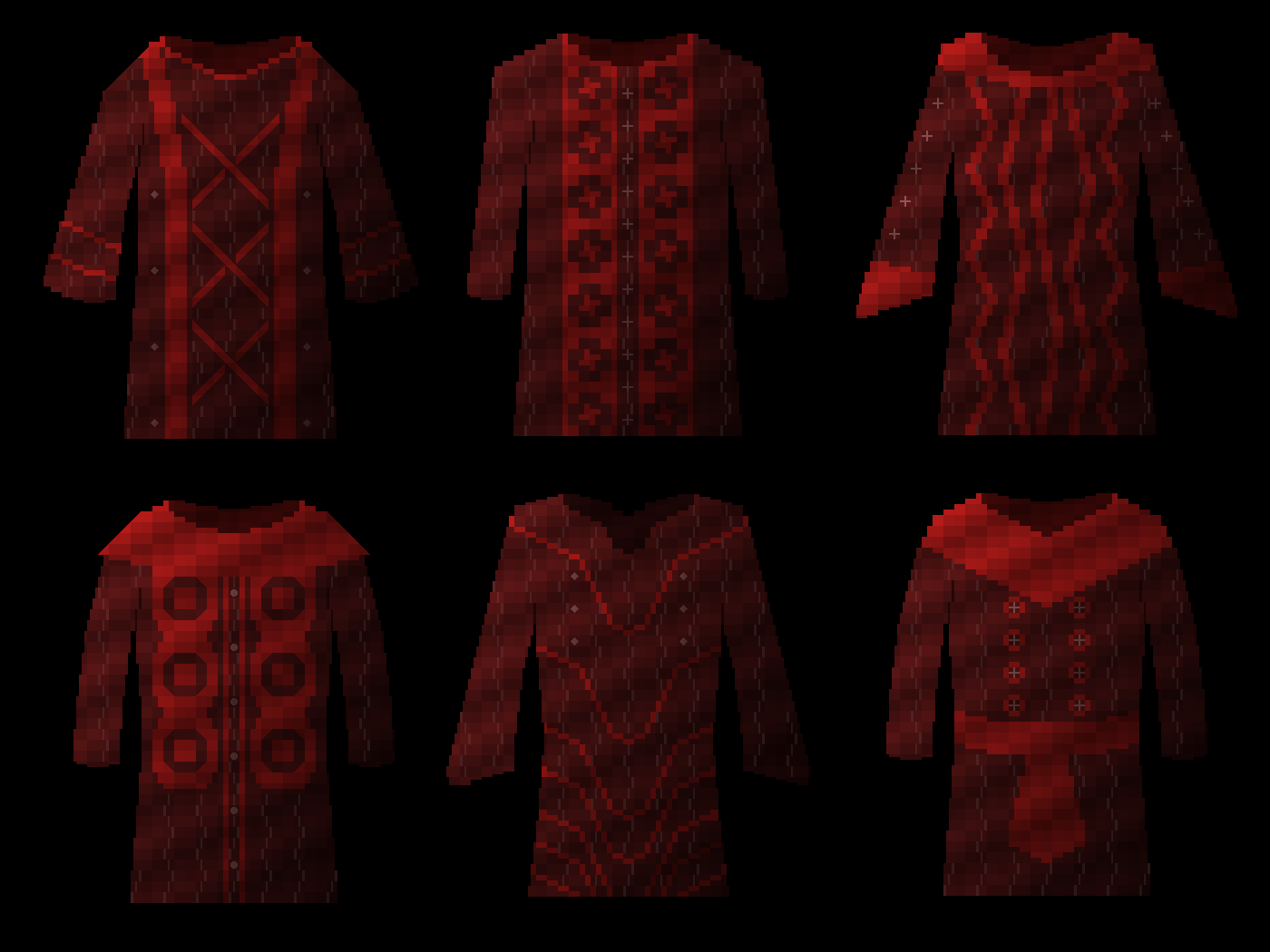
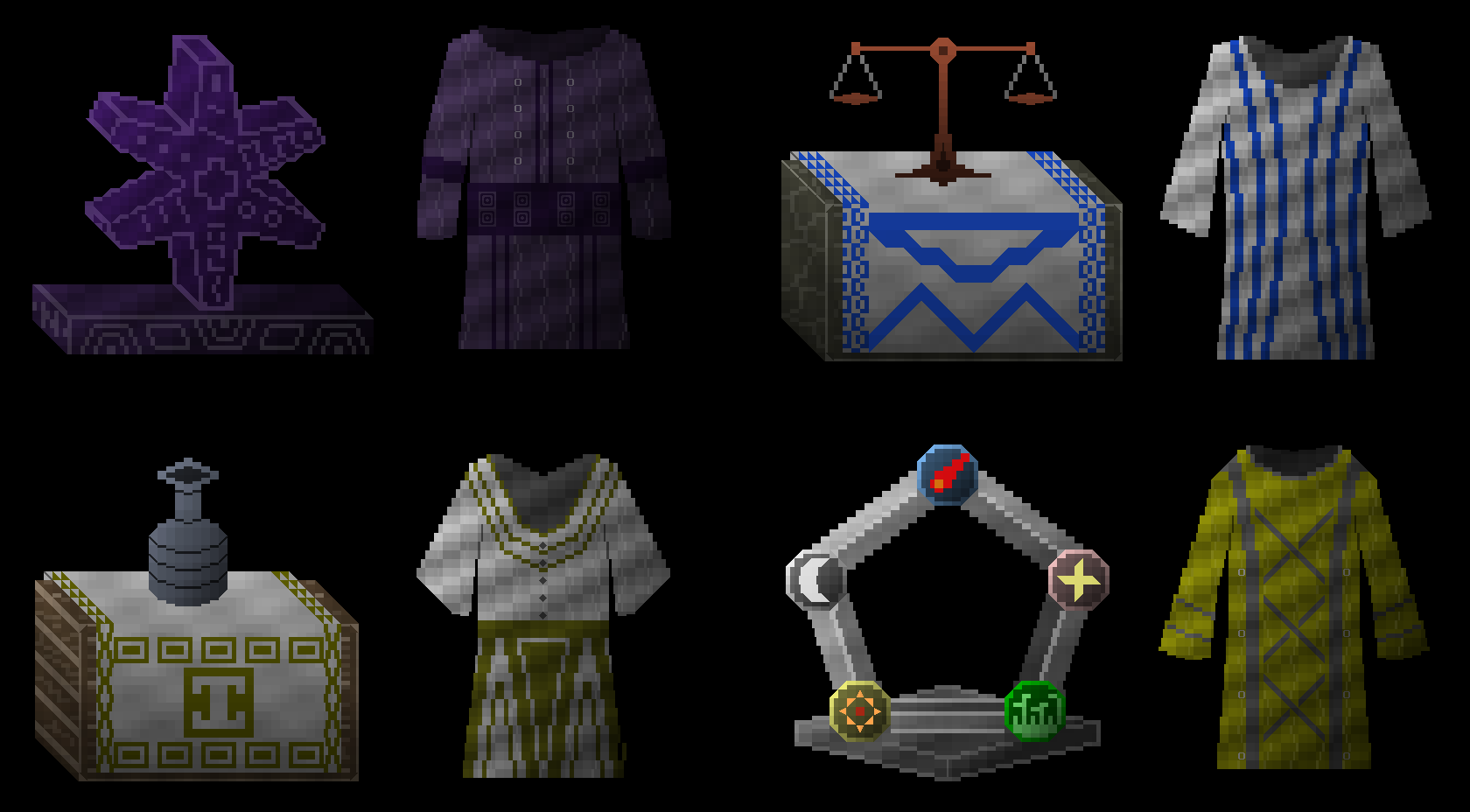

Priests use the same shoes as the nation they’re in, and usually the lower-class variation (though in some religions priests will be barefoot). With these done, that means approximately half the clothing generation for 0.8 is done – feudal clothing is 99% finished (I just need to put in a few final touches to the lower-class variations) and religious clothing is now finished. I’ll probably work on nomadic clothing next, as I have a few ideas of what archetypes I want to generate those around, then I’ll do hunter-gatherer clothing probably last before this version’s release. Armour and things like that will come later (0.9?) so for the time being, all soldiers and other military personnel just have lower-class clothing, or upper/middle-class if they are officers (which in the future they’ll probably keep, but just wear beneath their armour).
Slums and Encampments
The last few areas which needed handling for NPCs have been dealt with. NPC crowds now spawn, move and despawn intelligently in slums outside major cities, and also in hunter-gatherer encampments. Pictures of slum, and encampment, and example crowds:
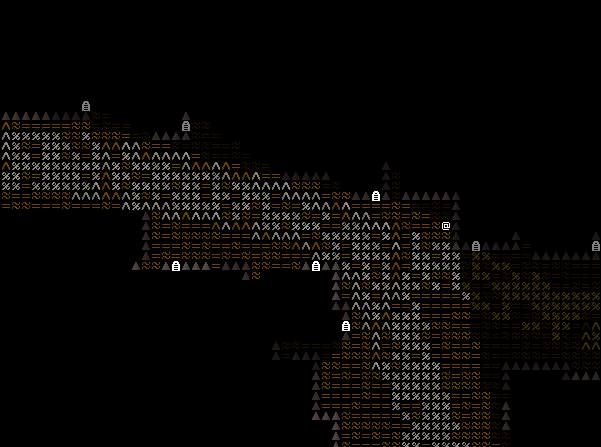
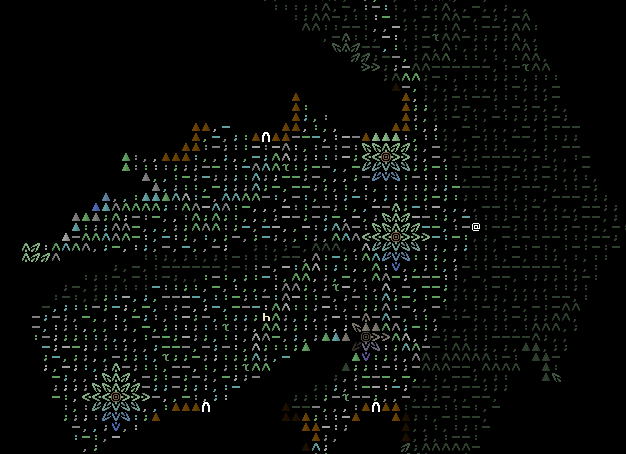
Remaining Interior Behaviour
All buildings which can have crowds in them (e.g. a tavern can have randoms wander in. but a royal mint cannot) now have those crowds behaving intelligently at all times, and – as far as I can tell – this is entirely glitch/bug/crash free regardless of what building, what civilization, what demographics the NPCs in question are, etc. Here are some examples of an arena and a longhouse, since I thought these were both rather pleasing, especially in the longhouse as people gather around the table:
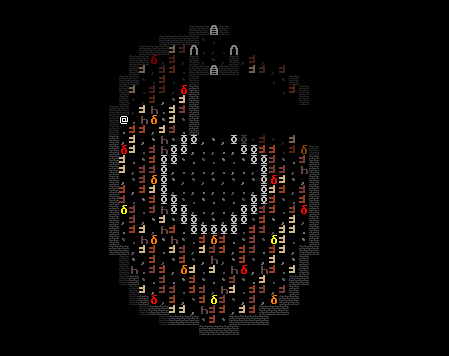
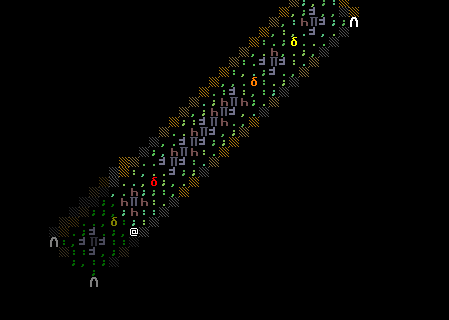
Pathfinding Problems
Some buildings and some parts of the external map were starting to produce a problem – if you had two NPCs (or an NPC and the player) trying to get through the same one-tile tunnel between walls, at the same time, then they couldn’t slip past each other. I implemented a temporary solution (whereby crowd NPCs will look for another objective if they find someone blocking the one-tile route down to their current objective) but this wasn’t good enough for the future, especially once we begin handling important NPCs whose paths cannot just be changed on a whim. So, now, if you have two NPCs who meet, and NPC 1 is trying to move onto the tile NPC 2 is on, and NPC 2 wants to move onto the tile NPC 1 is on, *and neither of them can find another way around* by stepping on a diagonal, and they would both allow the other to step past them (so they aren’t enemies), then the game will look at which one of them has the longest wait until their next turn, and then schedule a special “simultaneous” turn for them both to switch places at the same instant for that more distant turn (so that neither NPC can move “faster” than it should be able to). I’ve now implemented this to work indoors and work outdoors, so here’s an outdoor (filmed in “slow motion” to make it clear) example of this:
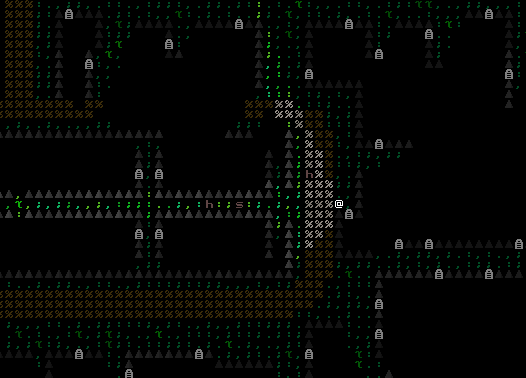
However, this became trickier when I wanted to combine it with the player. Clearly the player should be able to do this as well, but it required writing quite a hefty new chunk of code, for handling if the player tries to move through an NPC, or an NPC tries to move through the player, because obviously I don’t want to remove agency from the player, or allow NPCs to shove the player around the place (as that would get quickly annoying), but nor should the player somehow be able to exploit this ability to move NPCs around the map (I’m not sure how this could be an issue in the future, but it seems better to just produce a robust system now rather than worrying about it later). Either way, we clearly needed a way for NPCs to walk past the player if the player is being an ass and standing in the way:
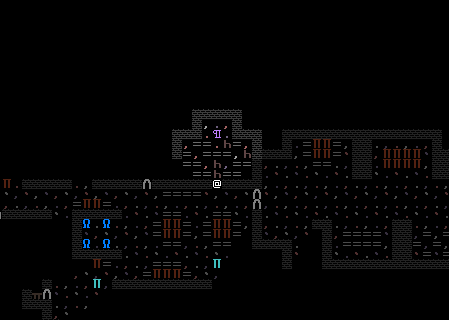
So, there are two scenarios: what if the player wants to move onto another NPC, and what is another NPC wants to move onto the player. It would be deeply annoying to allow the player’s character to be “pushed around” by other NPCs, so that was something I knew I had to avoid, but at the same time I had to ensure that you cannot exploit the system by somehow pushing around NPCs yourself. If an NPC wants to move onto the player, therefore, they initiate a special two-turn move, where the NPC takes two turns instead of one and “squeezes” past the player, taking both moves on the second turn – so from the player’s perspective, the NPC moves next to them on Turn 0, remains there for Turn 1, and then moves to the other side of them on Turn 2. If the player moves in the interim, then normal pathfinding resumes and the two-turn move is cancelled. (Of course, the two turn move only works if the tile beyond the player is free, the player and the NPC’s relations are friendly enough that the player would let the NPC get past, etc). Here’s an example, where I start off looking at the approaching slave, then turn to the other side, and sure enough the slaves pass “through me” using this special two-turn move:
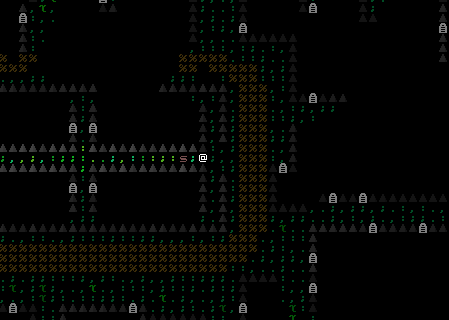
This also results in a message being printed, along the lines of “The [NPC type] squeezes past you”. The other version is; what if the player wants to get past an NPC who is blocking a one-tile area? An NPC blocking a one-tile area and standing *still* should be an impossible scenario – I am certain there are no areas which are valid for crowd NPCs adopting the “meandering” walking type which are also only one-tile wide – so if one encounters an NPC in an enclosed space, it’ll be if you and the NPC are moving towards each other and need to cross over. If the NPC “initiates” the move, we get the scenario shown above. If the player initiates the move, then the game looks at both the player and the NPC, does the usual check of whether they are allowed to move through or not (this might have to wait until 0.9, as it’s going to be a complex calculation – for now it just returns “yes”) and then, if so, it has the player move along with the obstructing person during the later of their two turns (so if the player is next scheduled to move on turn 18174, and the NPC on turn 18175, then both will move on 18175, so that neither character is able to have a “free turn”). You then switch places with them, as shown in this example, where I step into an NPC who I am friendly enough with to switch places, then I turn around (taking one turn) and we therefore see the NPC two turns behind me, and they then leave. Had I just stood still, then they would have initiated the two-turn move, going “through” me without forcing my movement.

The three systems shown here also work when indoors as well as outdoors. These are all very rare scenarios, and I suspect will (for the most part) only happen if the player is standing deliberately still to try to annoy the NPCs, but it still needed handling. With all of this done, I am now… 99% that all NPCs of all categories, whether inside or outside, and whether dealing with the layout of the terrain, the motion of other NPCs, or the motion of the player themselves, should be able to path correctly past any obstacles (I think there is still one final minor non-crash bug here involving NPCs who have stopped to admire something, and if they have stopped in a “line”, then other NPCs may struggle to get past, but I’m working on fixing that one). As a last note on this, it’s also worth noting that in almost all cases I’ve worked hard to ensure every corridor/path both inside and outside is, in most cases, at least two tiles wide. However, in certain areas – slave quarters, some cathedral generations, slums, and a bunch of other places – one tile corridors can generate, so it was clearly important to handle these sorts of scenarios.
Also, now I need to at some point have you be able to switch your “walking style” from “walking” to “shoving” (or “pushing”, maybe?) so that in the rare possibility of a blockade (which I *think* should be impossible, as I’ve modeled spawning a bunch of NPCs on every tile in an enclosure and they’ve always managed to find their way out so far) you can always push your way through NPCs and force them all to move into the position you previously occupied, though that might not make them all that friendly to you. Nevertheless – and although I’m not even sure such a scenario can ever happen – it seems like an important addition which I’ll probably add this release, and it should be simple (note if there’s an NPC there, and if so, just switch places with it).
Campfires
Hunter-gatherer encampments now have campfires, beds, and tables. Only the fires so far have an image, but the beds and tables will be made of either wood or stone, and will get images before the end of this release:
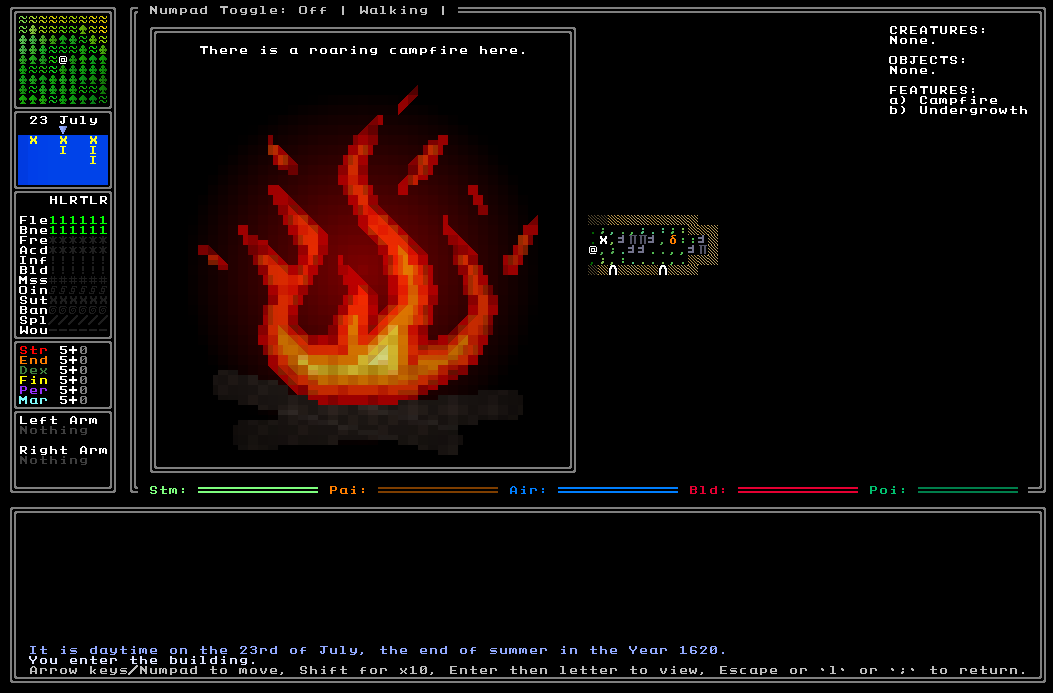
We still need more variation and detail in these areas – a lot more, honestly – but hunter-gatherer areas now look slightly less bleak and empty than they did a little while ago (in the above picture you can see some stone chair/tables and a second fire). More soon, hopefully, though anything beyond tables, chairs and beds might have to wait until 0.9 or a little beyond. I’m focusing on feudal nations this release (although all NPCs will be present), and it’ll probably be the next release when I do more on nomadic and hunter-gatherer NPCs and societies.
Guards
We now have guards! Guards appear outside Parliaments, Mints, Embassies, Officers’ Quarters, Armouries, Mansions and Citadels in the middle of Fortresses, and also inside Banks and Arenas (the former to guard the vaults, the latter to keep the crowd at bay and make sure nobody interferes with the combat). The game also now notes every part of the map which needs a special “permission” in order to access it, and guards are tethered to certain permissions, meaning that if the player steps onto a tile which has the (‘Embassy’,24) permission and the player isn’t from the nation with the id# 24, then the guards will act – right now the game just registers this since the conversation system isn’t in yet, but that’s the plan. So, here are some guards doing their guarding thing (they currently wear standard clothing since armour generation doesn’t exist yet):
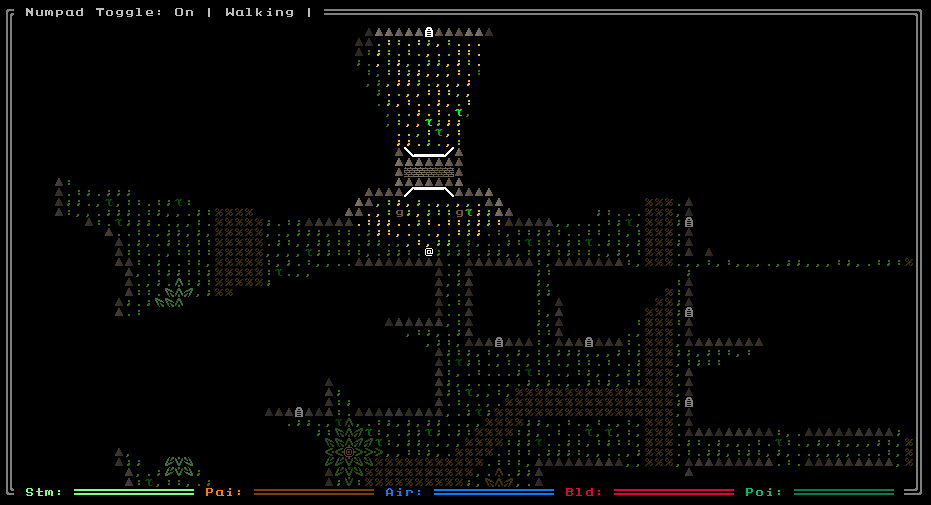
And then here’s a slice of the visual map, and the “forbidden” map, which shows the parts of the terrain close to the armoury door which will trigger the ire of the guards, so we can see that anything within the courtyard, and some of the tiles just outside the the gate, will trigger their ire (the guards don’t show up on this view, but as we saw above, the guards are basically standing just outside the gate):
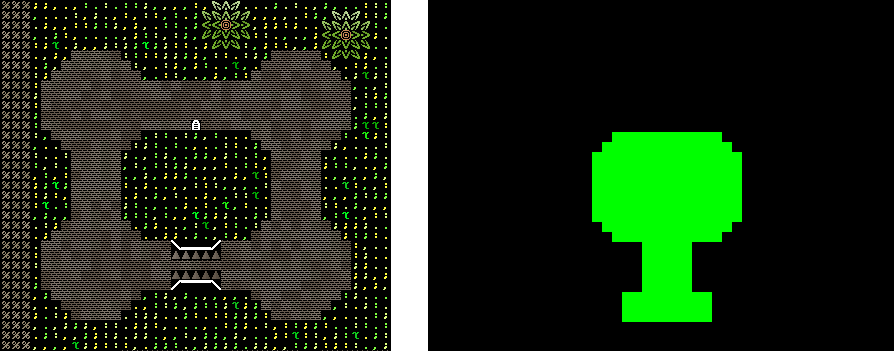
So, now we just wait until later this release when I get working on a conversation system and the guards can accost you! More on this later once I figure out how precisely it works, but all the guards spawn, and detect intruders, and that’s all that matters for now.
Distance Demographics
The crowd’s demographics now vary according to the expansiveness of the nation in question. By this I mean – if the nation is small, then all people spawn with the genetic demographics (skin tone, hair colour, eye colour, etc) of the capital, or nearby. If the nation is large, the game will sometimes look for a random tile in that nation’s territory to choose the demographics from (which is to say, if you’re in the capital city it’ll normally be a “capital person”, and sometimes someone from further out; if you’re in a town, it’ll normally be a “town person”, but sometimes someone from further out) and use those to spawn the person instead; and if the nation has colonies it’ll do the same. This means if you run into two people in a nation with the same cultural demographics (clothing, hairstyles, etc) but very different skintone/hair colour etc, then you can reasonably deduce that nation is either very large, or has some colonies somewhere. Here are two examples of this kind of crowd, and the latter you’ll note has a priest leading some followers (the priest of course now spawns with the right robes). Rather annoyingly I wasn’t able to quickly find a nation which had colonies/homelands with skin tones at the two extreme ends of the spectrum, but you still get the idea from these of a lot more variation in the larger and more expansive empires:
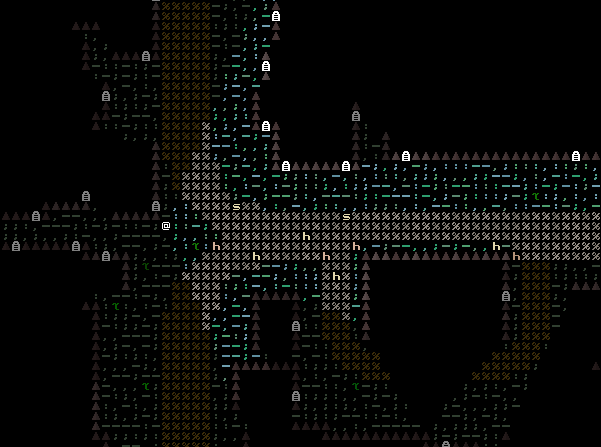
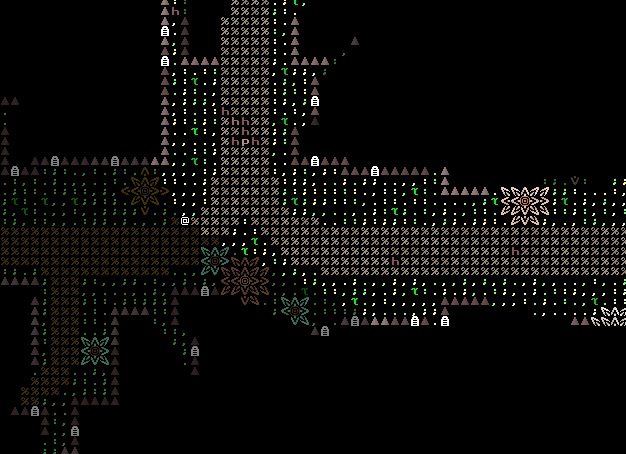
Another thing this has got me wondering: in future versions (0.9 or 0.10 onwards) all the map except your home nation will be in shroud when you start. Should colonies be “lit” or not? I think the best solution is that colonies don’t start as explored, and if you take a ship to one of your own nation’s colonies, perhaps all the colony land is then revealed when you arrive? In contrast, normally, you’ll just explore the tiles around you as you move, and if you take a ship, it will perhaps show you the ocean path you move along? That seems like a good compromise without having a situation where you start with a few chunks of the map explored which are disconnected from your nation’s homeland.
Lesser Houses
I’ve now implemented the first stage in generating families/houses which are less important than the small number at the top of each civilization (one of which, of course, belongs to the player) but are still noteworthy. In nations with the “Vassalage” ideology, one of these families will have a special “Manor” building spawn in each town in that nation, and a family rules each of these manors and therefore each town. In Vassalage nations the other smaller buildings in upper class districts will also belong to these families (so they have a manor, and a home in the capital), whilst in non-vassalage districts these buildings will also belong to second-tier families, but not “special” ones (as in, rich merchants or whatever, not those with direct feudal/political power). However, for the vassalage nations, these all needed coats of arms! So, I’ve returned to the sigil generation system and added in the ability for “lesser” houses to have coats of arms. These are much simpler than the major houses, and have a geometric pattern determined by the aesthetic preference of their nation (octagon, square, circle, cross, diamond) which feeds into an algorithmic sequence that combines various elements (I’ll also add a system ensuring there can’t be more than 5 vassalage nations, and they can’t share a shape, to ensure variety across the game world). Now, bearing in mind of course there are meant to be for lesser/more general houses… what do you think?
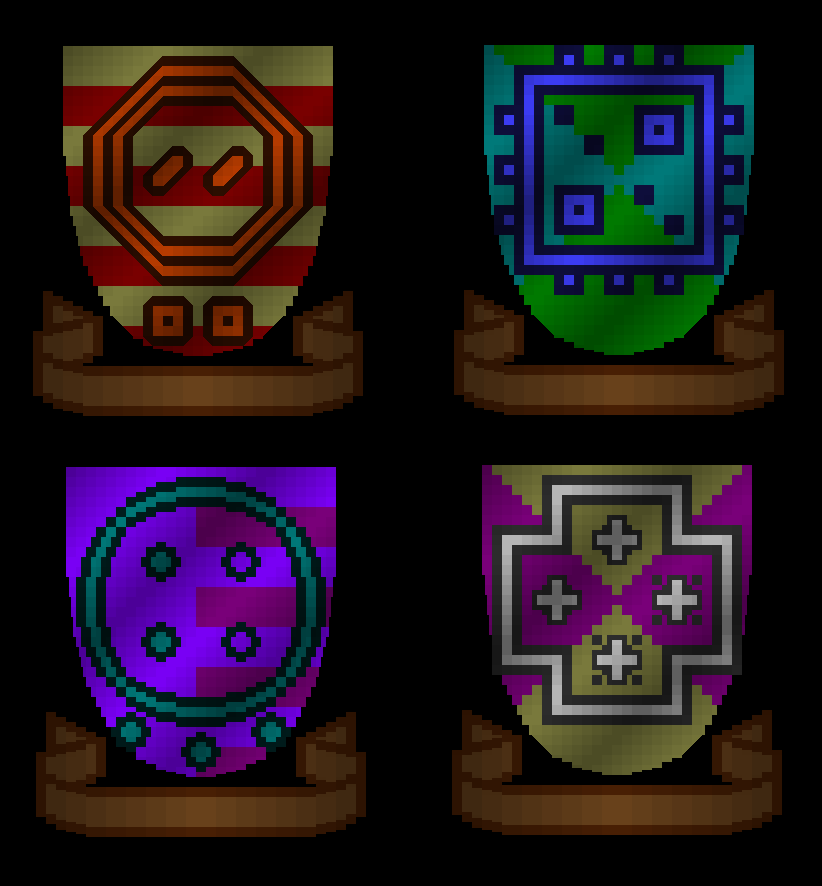
Compare, of course, with some examples of important families:
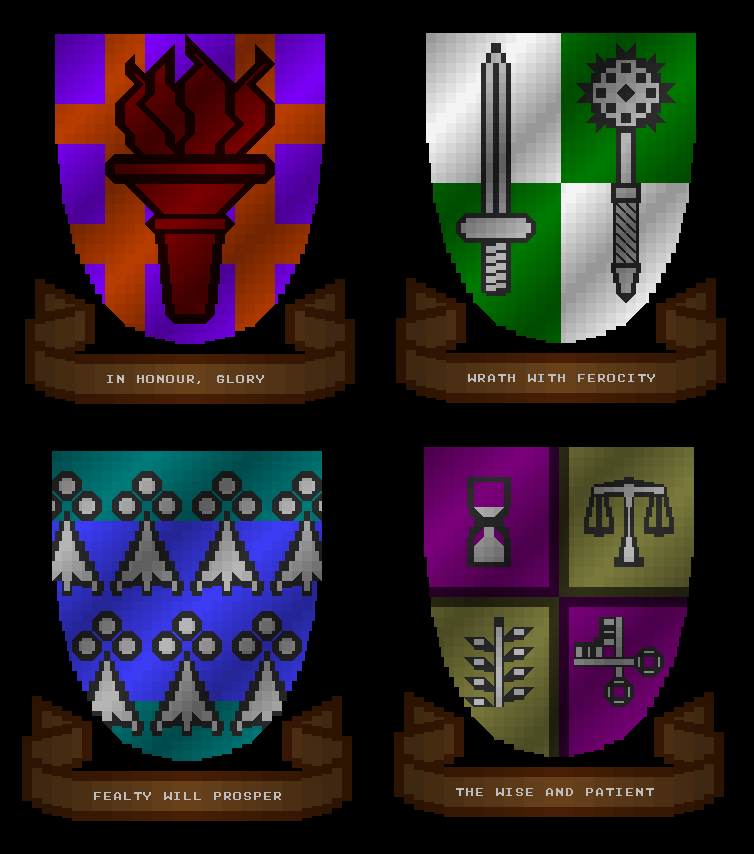
So what do you think of the minor ones? Good, bad, too little detail, too similar, just right…? Of course, they still need mottoes, and I’m thinking of having it tether them to the towns they’re from in some way (or perhaps these lesser houses don’t have mottoes?).
What next?
Next up I’ll be working on adding more “fixed” NPCs like guards – so this means tellers in banks, priests in religious buildings, servants in mansions, officers in officers’ quarters, delegates in parliaments, and so on. This week is probably also going to see a little bit of reworking of some aspects of world generation, since I need to add in a system for vassalage nations to generate and track these other houses, and for parliamentary nations to figure out how many delegates they should have (I have a cool system planned for this), and I might add in the new “Monastic” religious ideology I’ve been thinking about for a while too. Either way, I’d say we’re about 75% through NPC mechanics at this point, and in a fortnight or so I think everything with NPCs should be finished, and then we can move onto the other massive part of this release – conversations. See you next week!
